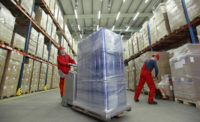Things to consider when buying warehouse space
Finding sufficient climate-controlled storage space poses one of the biggest challenges in the refrigerated sector.

Finding sufficient climate-controlled storage space poses one of the biggest challenges in the refrigerated sector. Typically, this type of warehouse space is limited and expensive. Companies often find that the usual method of renting presents challenges, especially for smaller enterprises. For food manufacturers and distributors looking to grow and gain better control their own supply chain, the purchase of a warehouse could be a viable alternative.
Generally, the demand for industrial space has exploded with the growth of e-commerce. In fact, demand for industrial space has exceeded supply for 32 of 33 quarters, creating an historic low vacancy rate of 4.3%, according to data from CBRE, Los Angeles. Likewise, Deloitte, Chicago, forecasts that by 2023, industrial real estate demand will increase by 850 million square feet to 14.8 billion square feet.
In the rental market, companies typically have to negotiate multi-year leases, a system that usually favors larger enterprises requiring a significant amount of year-round space over a longer period of time. Locked into a contract, manufacturers and distributors give up flexibility or have to pay for space. Public warehouse space is also an option, but this comes with its own supply chain challenges (i.e. cost to move goods to and from a specific location). Middle market and smaller companies often find themselves at a disadvantage, as their needs could be shorter-term or more seasonal.
Owning your own warehouse property could solve some of these difficulties. But, here are some things to consider when making that big purchase.
Think about future growth in assessing square footage. Of course, the size of your property depends upon the size of your company. Some companies need just 30,000 square feet; others require 400,000 square feet. The point is to incorporate future expansion plans into the purchase decision. Will you grow into the building? It might make sense to buy a larger property today and rent the excess space, providing an additional revenue stream.
Consider equipment and capital expenses. Financing the purchase price of the property is just the first step. Once you have the building, you’ll need new equipment, such as forklifts and racking. You may want an inventory management system or invest in other types of technology, such as robotics. You may need to hire additional personnel to staff the property.
To make your warehouse a fully functioning entity, you’ll need to have adequate cash flow for these additional expenses. You’ll also most likely require multiple forms of financing. The package could include a real estate loan to finance the purchase of the building, separate financing to cover equipment and working capital. Some companies also request a separate line of credit to tap into future equipment and fixed asset needs.
Include sustainability in due diligence. As with any major purchase, thorough research before you buy is critical. Make sure that the building is structurally sound. Examine the past uses of the property to ensure you don’t inherit any lingering environmental issues. Be in compliance with FDA regulations encompassing all relevant Food Safety Modernization Act (FSMA) requirements, including Food Safety Plans (FSP) and Hazard Analysis and Risk-based Preventive Controls (HARPC).
The potential to retrofit your warehouse facility for sustainability should also be a consideration in the purchase. For example, the installation of solar panels could result in significant savings.
The purchase of climate-controlled storage property could be a strategic choice for many refrigerated food companies. Compared with the constraints of renting, a warehouse purchase could constitute a crucial step for growth and a way to build equity in your company’s future.
Looking for a reprint of this article?
From high-res PDFs to custom plaques, order your copy today!







